The Land Of China -- Explore by Province
Henan
Henan is located in the eastern part of Central China and in the middle and lower reaches of the Yellow River. Covering an area of 167,000 square kilometers, the province has a monsoonal climate in the temperate zone. Its population is 90,270,000 and includes such nationalities as Han, Muslim, Mongolian, and Manchurian. The province contains 31 cities and 99 counties with its capital set in Zhengzhou.
Lying in the center of the China, the Central Kingdom, with the Yellow River floating through it, Henan is the cradle of China's 5000-year-long civilization. Three of China's Seven Ancient Capitals lie in this province: Luoyang, Kaifeng, and Anyang. The Peiligang, Yangshao, and Longshan cultures came into existence 8000, 5000, and 6000 years ago respectively. From the 11th Century B.C. to 1127 A.D., over 10 dynasties successively set up their capitals in Henan; the result is a plethora of ancient relics and ruins that are spread throughout the province. Henan's famous historical and cultural cities in the province are Luoyang, Kaifeng, Anyang, Nanyang, Shangqiu, Zhengzhou, and Jun County. The Jigong Mountain, the Song Mountain, the Longmen Grottoes, and the Mountain Wangwu are national key scenic spots.
Capital city, Zhengzhou, is 20 kilometers south of the Yellow River. Historians may want to fo sightseeing along the River, go to the Provincial Museum, one of the best in China, or visit the nearby ancient palace ruins and city walls. Dahecun (River Village) is a 5000-year-old site of neolithic cultures and ruins of the Shang dynasty, China's first dynasty.
The 17-square-kilometer Mangshan Tourist Area is a well-known scenic spot in the Central Plains that is characterized by the brilliant culture of the Yellow River. It is composed of four parts:
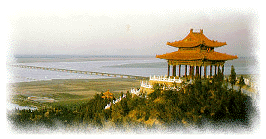 the Mangshan Tourist Area
the Mangshan Tourist Area
|
the Wanglongfeng Scenic Area, where the Water Conservancy Project to divert the Yellow River water to Zhengzhou was built in 1972; the Yueshan Temple Scenic Spot where the Zijin Tower and Iron Chain Bridge are found; the Luotuo (Camel) Bridge and its 10-meter-tall statue of Emperor Yu the Great; and the Stele Forest of the Yellow River containing 570 inscribed pieces by famous contemperary calligraphers. There is also the Hanba Erwangcheng Scenic Area, which is made up of East and West Guangwu cities, two royal cities built in 203 BC by Liu Bang, first Han emperor, and Xiangyu, ruler of the State of Chu, when the two pitted their forces against each other. Tourists may climb to the top of the mountain for a bird's eye view of the Yellow River or take a deluxe hovercraft ride to enjoy the beautiful scenery along the river.
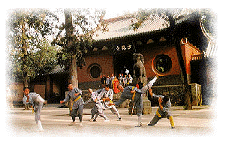 the Shaolin Temple
the Shaolin Temple
|
The Shaolin Temple was built in 495 A.D. and is located northwest of Dengfeng County on Song Shan. The Indian Monk Boddhidharma arrived in 527 and initiated the Chan (Zen) sect of Buddhism. Shaolin hence became the birthplace of the Chan Sect. At the beginning of the seventh century, 13 martial arts monks were rewarded by Tang Dynasty Emperor Li Shimin after they had saved him from danger . The Temple was then given the title: "the Number One Temple Under Heaven." Shaolin kung fu thus developed rapidly and its fame spread. The 30,000-square-meter temple is composed of seven rows of buildings, including the Hall of Heavenly King, the Dharma Pavilion, the Thousand-Buddha Hall, the White-Robe Bodhhisattva Hall, and the Hall of Ksitigarbba (Guardian of the Earth).
Situated in the Shrine of Zhou Gong southeast of Dengfeng County, the Observatory was set up by the famous astronomer Guo Shoujing over 700 years ago at the beginning of the Yuan Dynasty. It is the oldest observatory in China. The 9.5-meter-high square observatory is built of stone and brick with a staircase on the north side where visitors can climb to the top and look into the horizon. The depression in the north is a sundial that measures the shadow of the sunlight. North of the depression is Shigui, or a chart of the heaven, paved with 36 pieces of blue stone from south to north measuring 31.2 meters.
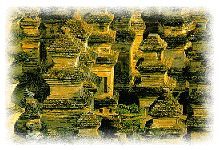 the Stupa Forest
the Stupa Forest
|
Three hundred meters northwest of Shaolin Temple is a cemetery for Shaolin monks, the Stupa Forest. Some 14,000 square meters in area, it is the largest of its kind in China with 243 brick and stone stupas of past dynasties. Rectangular, hexagonal, cylinderal, conical, bottlelike, or round in shape, the stupas have between one to seven tiers, the highest being 15 meters tall, as well as many carvings and inscriptions. It is a good place to study brick or stone architecture and sculpture.
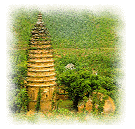 the Pagoda of Songyue
the Pagoda of Songyue
|
The Pagoda of the Songyue Temple is located 5 kilometers northwest of Dengfeng County. Built in 520 AD, it is the oldest Buddhist brick pagoda in China. Forty meters high with a circumference of 33.7meters, the 12-sided pagoda contains 15 tiers and a 2.5-meter-thick wall. On top is a 2-meter-high carved spiral column of stone. Built of small bricks mortared with clay, the pagoda stands in a perfect state despite 1,400 years of weathering.
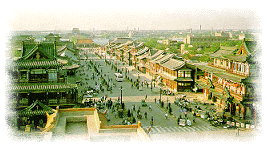 Song Du Yu Jie
Song Du Yu Jie
|
Song Du Yu Jie is the former Imperial Street which is now called Zhongshanlu Beiduan. It leads straight to the Palace of the Northern Song Dynasty and is 400 meters long and 30 meters wide with a ground area of 25,980 square meters. On both sides of the street are snack bars selling foods of various flavors, New Year picture studios, and shops that sell antiques, embroideries, and silks. On the north side of the street is a newly-built imitation of Gonglou or Faniou, the best of 72 restaurants in Dongjing of the Northern Song Dynasty. Gonglou consists of five 3-storied buildings: the east, west, south, north and middle, all facing each other and connected to one another. It mainly provides imperial dishes and confectionaries of the Northern Song Dynasty. Visiting this will provide some understanding of Song Dynasty customs.
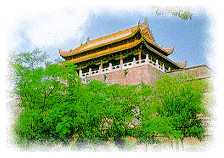 the Dragon Pavillion
the Dragon Pavillion
|
The Dragon Pavilion is situated in the northwest corner of Kaifeng and was formerly called the Longevity Pavilion. It It was built in 1692 during the 31st year of Emperor Qing Kangxi's reign, and a "Long Live The Emperor Tablet" is enshrined here. During festivals, officials, soldiers, and civilians come to pay their respects. The Great Hall is situated on a 13-meter-high brick platform, and the stone way is composed of three staircases with 72 steps. In the middle is a blue stone ramp with dragons carved into it. In front of the pavilion are the Pan and Yang's Lakes as the pavilion goes straight to the Yu Jie. In the reconstructed east and west side halls is China's first wax figure museum where historical stories of the Northern Song period are represented.
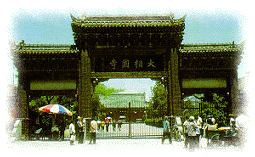 the Xiangguo Monastery
the Xiangguo Monastery
|
Xiangguo Monastery is located on Ziyou Lu Rd and was first built in 555. The Hall of Heavenly King, the Mahavira Hall, the Octagonal Glazed-Tile Hall, and the Scripture Preserving Hall are all structures of the Qing Dynasty. In the Octagonal Hall, you'll flnd a wooden statue of Avalokitesvara with four faces and one thousand hands and eyes. The 5-meter-high statue weighs 4 tons and is gilded all over, and it was carved from a thousand year old gingko in the time of Qianiong. In the Bell Tower, there is a giant bronze bell that was made during the Qing Dynasty. It is 3 meters high and weighs 5 tons. When it is striked, the bell can be heard all over the town. It is one of many attractions in Kaifeng.
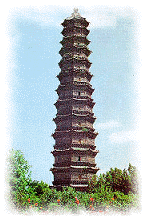 the Iron Pagoda
the Iron Pagoda
|
The Iron Pagoda was built in 1049 at the northeast corner of Kaifeng. It was named the Iron Pagoda because it was built with drab-colored glazed bricks of 28 different patterns that created the look of iron. The 13-storied octagonal pagoda is 55.1 meters high. More than 50 glazed brick carvings of female performers, flying Apasarus Buddhas, and lions are vividly portrayed with exquisite craftsmanship, and are considered masterpieces of the Song Dynasty.
The Lord Bao Memorial Hall was built at the site of former Kaifeng Prefecture of the Northern Song Dynasty to commemorate in honor his honesty and bravery in 1984. The 4,000-square-meter memmorial hall consists of a pavilion of steles. In the Main Hall there is a 3.5-meters-tall bronze statue of Bao Zheng and four large relief murals of glazed tiles depicting stories of Bao Zheng.
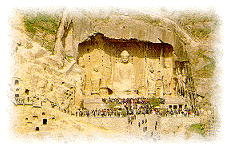 the Longmen Grottoes
the Longmen Grottoes
|
The Longmen Grottoes stretch for more than one kilometer on the west bank of the Yihe River, 12 kilometers south of Luoyang. It is one of the three great treasures of grotto art in China. Construction of the grottoes lasted 400 years and its landscape is acclaimed to be best of the Eight Sights of Luoyang. There are more than 2,100 grotto niches, 43 pagodas, 3,600 tablets and steles, and more than 100,000 statues, of which the biggest stands 17.1 meters tall and the smallest only 2 centimeters.
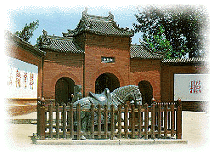 the White Horse Temple
the White Horse Temple
|
The White Horse Temple is located 12.5 kilometers east of Luoyang. Built in 68 A.D. as the first Buddhist temple in China, it is regarded as an ancestral temple and is respectfully called "the Number One Ancient Temple in China". The story goes that two Indian monks brought the Buddhist scriptures to Luoyang on two horses; hence the name White Horse Temple. Extant are the Hall of Heavenly King, Mahavira Hall, Boddhisattiva Hall, Avalokitesvara Tower, Reception Hall, and Vairocana Tower. Two white horses flank the front gate. The big iron bell in Boddhisattiva Hall weighs 1250 kilograms and can be heard at a distance of 5 kilometers on a moonlit night.
Guandimiao is located 7 kilometers south of Luoyang and is said to be the burial place of the head of Guan Yu, a Shu general during the Three-Kingdom period. Built during the Ming and Qing dynasties are the Theatre Building, Primary Hall, Secondary Hall, the Bell and Drum Tower, and more. In both the Primary and Secondary Halls, there is a seated statue of Guan Yu with Guan Ping and Zhou Cang standing on both sides. Murals in the halls tell stories of the life of Guan Yu. Deep in the woods is a 20-meter-high statue of Guan Yu surrounded by an octagonal red wall. Before the tomb is a stele pavilion. There are more than 4,000 ancient cypress trees growing in the woods.
The Luoyang Ancient Tomb Museum is located in the Zhongtou Village of Luoyang. The 30,000-square-meter museum contains a floor space of 7,600 square meters and is of great scientific and artistic significance, being the first ancient tomb museum in China. The Prelude Hall is an imitation of Han Dynasty architecture. Standing on its two sides are annex halls where models of tombs of the primitive society and the slave society are on display. There are restorations of 22 ancient tombs from the west and east Han Dynasties to the Northern Song.
The Frog Pagoda stands in the ruins of the Baolun Temple in the ancient city of Shaanzhou. It was first pagoda built in the Tang Dynasty and rebuilt in the Jin. The 13-story brick pagoda is 26.5 meters high, has four sides, and has a conical top where one may enjoy good views of the city and the Yellow River. If you tap stones or clap your hands meters away from the pagoda, an echo may be heard. The sound is similar to that of a frog and is why it is named the Frog Pagoda. It is one of the best-known echo-producing structures in China.
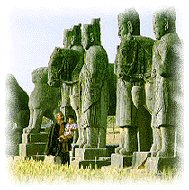 the Ancient Tomb of State Guo
the Ancient Tomb of State Guo
|
In 1956, thousands of relics were excavated from the tombs of Guo State at Beishangcunling, Sanmenxia. These included two bronze daggers inscribed "Guo Taizi Yuantu Ge:" the Prince of Guo State's, Yuantu's, dagger. In 1990, about 4,800 relics were excavated from Tomb Four including an iron sword with a jade handle, the oldest iron antique in China. The blade has deteriorated but the jade handle is still in good condition. Also at the Ancient Tomb of State Guo, many carriages and horses were buried with dead nobles of Guo State at Beishangcunling, Sanmenxia City. A total of 234 tombs, 3 carriage-and-horse burial grounds, and 10 horse pits have been excavated. The one on exhibit is the best preserved burial ground for carriages and horses. The rectangular pit is 15 meters long, 3.8 meters wide and 4.1 meters deep, and held 5 carriages and 10 horses. The wooden carriages are two wheeled and painted. Only one carriage is still in good condition. Gifts, weapons, horse & carriage gears and ornaments have also been unearthed at the site.



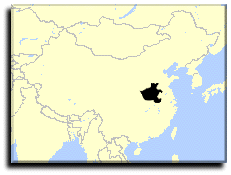
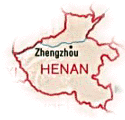














 Chinese Culture
Chinese Culture